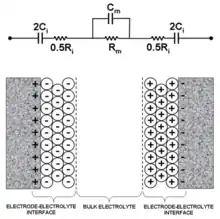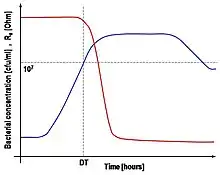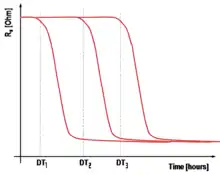Impedance microbiology
Impedance microbiology is a microbiological technique used to measure the microbial number density (mainly bacteria but also yeasts) of a sample by monitoring the electrical parameters of the growth medium. The ability of microbial metabolism to change the electrical conductivity of the growth medium was discovered by Stewart[1] and further studied by other scientists such as Oker-Blom,[2] Parson[3] and Allison[4] in the first half of 20th century. However, it was only in the late 1970s that, thanks to computer-controlled systems used to monitor impedance, the technique showed its full potential, as discussed in the works of Fistenberg-Eden & Eden,[5] Ur & Brown[6] and Cady.[7]
Principle of operation

When a pair of electrodes are immersed in the growth medium, the system composed of electrodes and electrolyte can be modeled with the electrical circuit of Fig. 1, where Rm and Cm are the resistance and capacitance of the bulk medium, while Ri and Ci are the resistance and capacitance of the electrode-electrolyte interface.[8] However, when frequency of the sinusoidal test signal applied to the electrodes is relatively low (lower than 1 MHz) the bulk capacitance Cm can be neglected and the system can be modeled with a simpler circuit consisting only of a resistance Rs and a capacitance Cs in series. The resistance Rs accounts for the electrical conductivity of the bulk medium while the capacitance Cs is due to the capacitive double-layer at the electrode-electrolyte interface.[9] During the growth phase, bacterial metabolism transforms uncharged or weakly charged compounds of the bulk medium in highly charged compounds that change the electrical properties of the medium. This results in a decrease of resistance Rs and an increase of capacitance Cs.
In impedance microbiology technique works this way, the sample with the initial unknown bacterial concentration (C0) is placed at a temperature favoring bacterial growth (in the range 37 to 42 °C if mesophilic microbial population is the target) and the electrical parameters Rs and Cs are measured at regular time intervals of few minutes by means of a couple of electrodes in direct contact with the sample.
Until the bacterial concentration is lower than a critical threshold CTH the electrical parameters Rs and Cs remain essentially constant (at their baseline values). CTH depends on various parameters such as electrode geometry, bacterial strain, chemical composition of the growth medium etc., but it is always in the range 106 to 107 cfu/ml.
When the bacterial concentration increases over CTH, the electrical parameters deviate from their baseline values (generally in the case of bacteria there is a decrease of Rs and an increase of Cs, the opposite happens in the case of yeasts).
The time needed for the electrical parameters Rs and Cs to deviate from their baseline value is referred as Detect Time (DT) and is the parameter used to estimate the initial unknown bacterial concentration C0.

In Fig. 2 a typical curve for Rs as well as the corresponding bacterial concentration are plotted vs. time. Fig. 3 shows typical Rs curves vs time for samples characterized by different bacterial concentration. Since DT is the time needed for the bacterial concentration to grow from the initial value C0 to CTH, highly contaminated samples are characterized by lower values of DT than samples with low bacterial concentration. Given C1, C2 and C3 the bacterial concentration of three samples with C1 > C2 > C3, it is DT1 < DT2 < DT3. Data from literature show how DT is a linear function of the logarithm of C0:[10][11]
where the parameters A and B are dependent on the particular type of samples under test, the bacterial strains, the type of enriching medium used and so on. These parameters can be calculated by calibrating the system using a set of samples whose bacterial concentration is known and calculating the linear regression line that will be used to estimate the bacterial concentration from the measured DT.

Impedance microbiology has different advantages on the standard plate count technique to measure bacterial concentration. It is characterized by faster response time. In the case of mesophilic bacteria, the response time range from 2 – 3 hours for highly contaminated samples (105 - 106 cfu/ml) to over 10 hours for samples with very low bacterial concentration (less than 10 cfu/ml). As a comparison, for the same bacterial strains the Plate Count technique is characterized by response times from 48 to 72 hours.
Impedance microbiology is a method that can be easily automated and implemented as part of an industrial machine or realized as an embedded portable sensor, while plate count is a manual method that needs to be carried out in a laboratory by long trained personnel.
Instrumentation
Over the past decades different instruments (either laboratory built or commercially available) to measure bacterial concentration using impedance microbiology have been built. One of the best selling and well accepted instruments in the industry is the Bactometer[12] by Biomerieux. The original instrument of 1984 features a multi-incubator system capable of monitoring up to 512 samples simultaneously with the ability to set 8 different incubation temperatures. Other instruments with performance comparable to the Bactometer are Malthus by Malthus Instruments Ltd (Bury, UK),[13] RABIT by Don Whitley Scientific (Shipley, UK)[14] and Bac Trac by Sy-Lab (Purkensdorf, Austria).[15] A portable embedded system for microbial concentration measurement in liquid and semi-liquid media using impedance microbiology has been recently proposed.[16][17] The system is composed of a thermoregulated incubation chamber where the sample under test is stored and a controller for thermoregulation and impedance measurements.
Applications
Impedance microbiology has been extensively used in the past decades to measure the concentration of bacteria and yeasts in different type of samples, mainly for quality assurance in the food industry. Some applications are, the determination of the shelf life of pasteurized milk[18] and the measure of total bacterial concentration in raw-milk,[19][20] frozen vegetables,[21] grain products,[22] meat products[23] and beer.[24][25] The technique has been also used in environmental monitoring to detect the coliform concentration in water samples as well as other bacterial pathogens like E.coli present in water bodies,[26][27][28] in the pharmaceutical industry to test the efficiency of novel antibacterial agents[29] and the testing of final products.
References
- Stewart, G.N. (1899). "The changes produced by the growth of bacteria in the molecular concentration and electrical conductivity of culture media". Journal of Experimental Medicine. 4 (2): 235–243. doi:10.1084/jem.4.2.235. PMC 2118043. PMID 19866908.
- Oker-Blom, M (1912). "Die elektrische Leitfahigkeit im dienste der Bakteriologie". Zentralbl Bakteriol. 65: 382–389.
- Parsons, L.B.; Sturges, W.S. (1926). "The possibility of the conductivity method as applied to studies of bacterial metabolism". Journal of Bacteriology. 11 (3): 177–188. doi:10.1128/JB.11.3.177-188.1926. PMC 374863. PMID 16559179.
- Allison, J.B.; Anderson, J.A.; Cole, W.H. (1938). "The method of electrical conductivity in studies of bacterial metabolism". Journal of Bacteriology. 36 (6): 571–586. doi:10.1128/JB.36.6.571-586.1938. PMC 545411. PMID 16560176.
- Fistenberg-Eden, R.; Eden, G. (1984). Impedance Microbiology. New York: John Wiley.
- Ur, A.; Brown, D.F.J. (1975). Monitoring of bacterial activity by impedance measurements. New York: Chapter 5 in “New approaches to the identification of microorganisms”, edited by C. Heden & T. Illeni, John Wiley & Sons. pp. 63–71.
- Cady, P. (1978). Progress in impedance measurements in microbiology. Springfield: Chapter 14 in “Mechanizing microbiology” edited by Anthony N. Sharpe & David S. Clark, Charles C. Thomas Publisher. pp. 199–239.
- Grossi, M.; Lanzoni, M.; Pompei, A.; Lazzarini, R.; Matteuzzi, D.; Riccò, B. (June 2008). "Detection of microbial concentration in ice-cream using the impedance technique". Biosensors and Bioelectronics. 23 (11): 1616–1623. doi:10.1016/j.bios.2008.01.032. PMID 18353628.
- Felice, C.J.; Valentinuzzi, M.E.; Vercellone, M.I.; Madrid, R.E. (1992). "Impedance bacteriometry: medium and interface contributions during bacterial growth". IEEE Transactions on Biomedical Engineering. 39 (12): 1310–1313. doi:10.1109/10.184708. PMID 1487295. S2CID 20555314.
- Grossi, M.; Pompei, A.; Lanzoni, M.; Lazzarini, R.; Matteuzzi, D.; Riccò, B. (2009). "Total bacterial count in soft-frozen dairy products by impedance biosensor system". IEEE Sensors Journal. 9 (10): 1270–1276. Bibcode:2009ISenJ...9.1270G. doi:10.1109/JSEN.2009.2029816. S2CID 36545815.
- Silverman, M.P.; Munoz, E.F. (1979). "Automated electrical impedance technique for rapid enumeration of fecal coliforms in effluents from sewage treatment plants". Applied and Environmental Microbiology. 37 (3): 521–526. Bibcode:1979STIA...7939970S. doi:10.1128/AEM.37.3.521-526.1979. PMC 243248. PMID 378128.
- Priego, R.; Medina, L.M.; Jordano, R. (2011). "Bactometer system versus traditional methods for monitoring bacteria populations in salchichón during its ripening process". Journal of Food Protection. 74 (1): 145–148. doi:10.4315/0362-028X.JFP-10-244. PMID 21219778.
- Jawad, G.M.; Marrow, T.; Odumeru, J.A. (1998). "Assessment of impedance microbiological method for the detection of Escherichia Coli in foods". Journal of Rapid Methods & Automation in Microbiology. 6 (4): 297–305. doi:10.1111/j.1745-4581.1998.tb00210.x.
- "RABIT instrument".
- "Bac Trac instrument".
- Grossi, M.; Lanzoni, M.; Pompei, A.; Lazzarini, R.; Matteuzzi, D.; Riccò, B. (2010). "An embedded portable biosensor system for bacterial concentration detection". Biosensors & Bioelectronics (Submitted manuscript). 26 (3): 983–990. doi:10.1016/j.bios.2010.08.039. PMID 20833014.
- Grossi, M.; Lazzarini, R.; Lanzoni, M.; Pompei, A.; Matteuzzi, D.; Riccò, B. (2013). "A portable sensor with disposable electrodes for water bacterial quality assessment" (PDF). IEEE Sensors Journal. 13 (5): 1775–1781. Bibcode:2013ISenJ..13.1775G. doi:10.1109/JSEN.2013.2243142. S2CID 24631451.
- Bishop, J.R.; White, C.H.; Fistenberg-Eden, R. (1984). "Rapid impedimetric method for determining the potential shelf-life of pasteurized whole milk". Journal of Food Protection. 47 (6): 471–475. doi:10.4315/0362-028X-47.6.471. PMID 30934476.
- Grossi, Marco; Lanzoni, Massimo; Pompei, Anna; Lazzarini, Roberto; Matteuzzi, Diego; Ricco, Bruno (2011). "A portable biosensor system for bacterial concentration measurements in cow's raw milk" (PDF). 2011 4th IEEE International Workshop on Advances in Sensors and Interfaces (IWASI). pp. 132–137. doi:10.1109/IWASI.2011.6004703. ISBN 978-1-4577-0623-3. S2CID 44834186.
- Gnan, S.; Luedecke, L.O. (1982). "Impedance measurements in raw milk as an alternative to the standard plate count". Journal of Food Protection. 45 (1): 4–7. doi:10.4315/0362-028X-45.1.4. PMID 30866349.
- Hardy, D.; Kraeger, S.J.; Dufour, S.W.; Cady, P. (1977). "Rapid detection of microbial contamination in frozen vegetables by automated impedance measurements". Applied and Environmental Microbiology. 34 (1): 14–17. doi:10.1128/AEM.34.1.14-17.1977. PMC 242580. PMID 329759.
- Sorrels, K.M. (1981). "Rapid detection of bacterial content in cereal grain products by automated impedance measurements". Journal of Food Protection. 44 (11): 832–834. doi:10.4315/0362-028X-44.11.832. PMID 30856750.
- Fistenberg-Eden, R. (1983). "Rapid estimation of the number of microorganisms in raw meat by impedance measurement". Food Technology. 37: 64–70.
- Pompei, A.; Grossi, M.; Lanzoni, M.; Perretti, G.; Lazzarini, R.; Riccò, B.; Matteuzzi, D. (2012). "Feasibility of lactobacilli concentration detection in beer by automated impedance technique". MBAA Technical Quarterly. 49 (1): 11–18. doi:10.1094/TQ-49-1-0315-01.
- Evans, H.A.V. (1982). "A note on two uses for impedimetry in brewing microbiology". Journal of Applied Bacteriology. 53 (3): 423–426. doi:10.1111/j.1365-2672.1982.tb01291.x.
- Kaur, Harmanjit; Shorie, Munish; Sabherwal, Priyanka; Ganguli, Ashok (2017). "Bridged Rebar Graphene functionalized aptasensor for pathogenic E. coli O78:K80:H11 detection". Biosensors and Bioelectronics. 98: 486–493. doi:10.1016/j.bios.2017.07.004. PMID 28728009.
- Colquhoun, K.O.; Timms, S.; Fricker, C.R. (1995). "Detection of Escherichia Coli in potable water using direct impedance technology". Journal of Applied Microbiology. 79 (6): 635–639. doi:10.1111/j.1365-2672.1995.tb00948.x. PMID 8557618.
- Strauss, W.M.; Malaney, G.W.; Tanner, R.D. (1984). "The impedance method for monitoring total coliforms in wastewaters". Folia Microbiologica. 29 (2): 162–169. doi:10.1007/bf02872933. PMID 6373524. S2CID 21980065.
- Gould, I.M.; Jason, A.C.; Milne, K. (1989). "Use of the Malthus growth analyzer to study the post-antibiotic effect of antibiotics". Journal of Antimicrobial Chemotherapy. 24 (4): 523–531. doi:10.1093/jac/24.4.523. PMID 2515188.